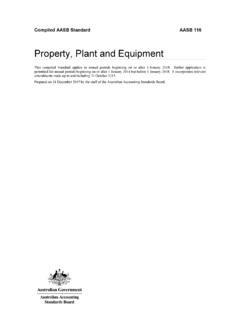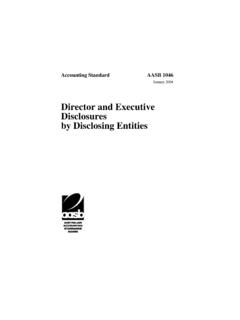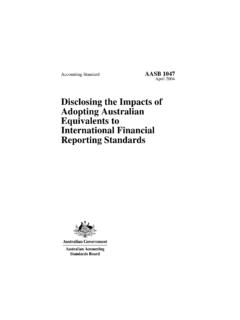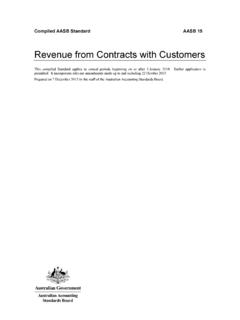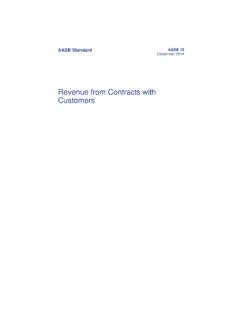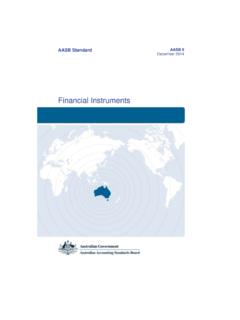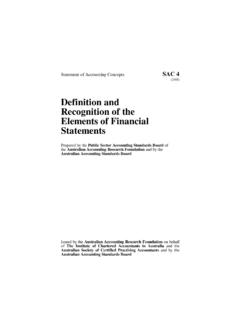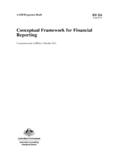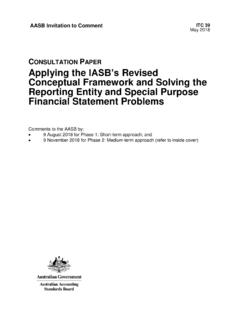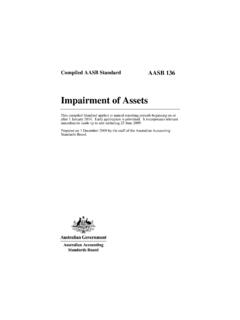Transcription of Financial Instruments - Australian Accounting Standards …
1 compiled aasb Standard aasb 9 Financial Instruments This compiled Standard applies to annual periods beginning on or after 1 January 2019 but before 1 January 2021. Earlier application is permitted for annual periods beginning after 24 July 2014 but before 1 January 2019. It incorporates relevant amendments made up to and including 12 December 2017. Prepared on 29 March 2019 by the staff of the Australian Accounting Standards board . Compilation no. 1 Compilation date: 31 December 2018 Authorised Version F2019C00422 registered 15/05/2019 aasb 9- compiled 2 COPYRIGHT Obtaining copies of Accounting Standards compiled versions of Standards , original Standards and amending Standards (see Compilation Details) are available on the aasb website: Australian Accounting Standards board PO Box 204 Collins Street West Victoria 8007 AUSTRALIA Phone: (03) 9617 7600 E-mail: Website: Other enquiries Phone: (03) 9617 7600 E-mail: COPYRIGHT Commonwealth of Australia 2019 This compiled aasb Standard contains IFRS Foundation copyright material.
2 Reproduction within Australia in unaltered form (retaining this notice) is permitted for personal and non-commercial use subject to the inclusion of an acknowledgment of the source. Requests and enquiries concerning reproduction and rights for commercial purposes within Australia should be addressed to The National Director, Australian Accounting Standards board , PO Box 204, Collins Street West, Victoria 8007. All existing rights in this material are reserved outside Australia. Reproduction outside Australia in unaltered form (retaining this notice) is permitted for personal and non-commercial use only. Further information and requests for authorisation to reproduce for commercial purposes outside Australia should be addressed to the IFRS Foundation at Authorised Version F2019C00422 registered 15/05/2019 aasb 9- compiled 3 CONTENTS Contents COMPARISON WITH IFRS 9 Accounting STANDARD aasb 9 Financial Instruments from paragraph Chapter 1 Objective and application Commencement Chapter 2 Scope Chapter 3 Recognition and derecognition Initial recognition Regular way purchase or sale of Financial assets Derecognition of Financial assets Transfers that qualify for derecognition Transfers that do not qualify for derecognition Continuing
3 Involvement in transferred assets All transfers Derecognition of Financial liabilities Chapter 4 Classification Classification of Financial assets Option to designate a Financial asset at fair value through profit or loss Classification of Financial liabilities Option to designate a Financial liability at fair value through profit or loss Embedded derivatives Hybrid contracts with Financial asset hosts Other hybrid contracts Reclassification Chapter 5 Measurement Initial measurement Subsequent measurement of Financial assets Subsequent measurement of Financial liabilities Amortised cost measurement Financial assets Impairment Recognition of expected credit losses Simplified approach for trade receivables.
4 Contract assets and lease receivables Measurement of expected credit losses Reclassification of Financial assets Gains and losses Investments in equity Instruments Liabilities designated as at fair value through profit or loss Assets measured at fair value through other comprehensive income Chapter 6 Hedge Accounting Objectives and scope of hedge Accounting Hedging Instruments Qualifying Instruments Designation of hedging Instruments Hedged items Qualifying items Designation of hedged items Qualifying criteria for hedge Accounting Authorised Version F2019C00422 registered 15/05/2019 aasb 9- compiled 4 CONTENTS Accounting for qualifying hedging relationships Fair value hedges Cash flow hedges Hedges of a net investment in a foreign operation Accounting for the time value of options Accounting for the forward element of forward contracts and foreign currency basis spreads of Financial Instruments Hedges of a group of items Eligibility of a group of items as the hedged item Designation of a component of a nominal amount Presentation Nil net positions Option to designate a credit exposure as measured at fair value through profit or loss Eligibility of credit exposures for designation at fair value through profit or loss Accounting for credit exposures
5 Designated at fair value through profit or loss Chapter 7 Effective date and transition Effective date Transition Transition for classification and measurement (Chapters 4 and 5) Transition for hedge Accounting (Chapter 6) Entities that have applied aasb 9 (December 2009) or aasb 9 (December 2010) early Transition for Prepayment Features with Negative Compensation Appendices A Defined terms B Application guidance C Australian implementation guidance for not-for-profit entities COMPILATION DETAILS DELETED IFRS 9 TEXT AVAILABLE ON THE aasb WEBSITE Introduction to IFRS 9 Implementation Guidance on IFRS 9 Basis for Conclusions on IFRS 9 Australian Accounting Standard aasb 9 Financial Instruments (as amended) is set out in paragraphs and Appendices A C.
6 All the paragraphs have equal authority. Paragraphs in bold type state the main principles. Terms defined in Appendix A are in italics the first time they appear in the Standard. aasb 9 is to be read in the context of other Australian Accounting Standards , including aasb 1048 Interpretation of Standards , which identifies the Australian Accounting Interpretations, and aasb 1057 Application of Australian Accounting Standards . In the absence of explicit guidance, aasb 108 Accounting Policies, Changes in Accounting Estimates and Errors provides a basis for selecting and applying Accounting policies. Authorised Version F2019C00422 registered 15/05/2019 aasb 9- compiled 5 COMPARISON Comparison with IFRS 9 aasb 9 Financial Instruments as amended incorporates IFRS 9 Financial Instruments as issued and amended by the International Accounting Standards board (IASB).
7 Australian -specific paragraphs (which are not included in IFRS 9) are identified with the prefix Aus . Paragraphs that apply only to not-for-profit entities begin by identifying their limited applicability. Tier 1 For-profit entities complying with aasb 9 also comply with IFRS 9. Not-for-profit entities compliance with IFRS 9 will depend on whether any Aus paragraphs that specifically apply to not-for-profit entities provide additional guidance or contain applicable requirements that are inconsistent with IFRS 9. aasb 1053 Application of Tiers of Australian Accounting Standards explains the two tiers of reporting requirements. Authorised Version F2019C00422 registered 15/05/2019 aasb 9- compiled 6 STANDARD Accounting Standard aasb 9 The Australian Accounting Standards board made Accounting Standard aasb 9 Financial Instruments under section 334 of the Corporations Act 2001 on 17 December 2014.
8 This compiled version of aasb 9 applies to annual periods beginning on or after 1 January 2019 but before 1 January 2021. It incorporates relevant amendments contained in other aasb Standards made by the aasb up to and including 12 December 2017 (see Compilation Details). Accounting Standard aasb 9 Financial Instruments Chapter 1 Objective and application The objective of this Standard is to establish principles for the Financial reporting of Financial assets and Financial liabilities that will present relevant and useful information to users of Financial statements for their assessment of the amounts, timing and uncertainty of an entity s future cash flows.
9 This Standard applies to: (a) each entity that is required to prepare Financial reports in accordance with Part of the Corporations Act and that is a reporting entity; (b) general purpose Financial statements of each other reporting entity; and (c) Financial statements that are, or are held out to be, general purpose Financial statements. This Standard applies to annual reporting periods beginning on or after 1 January 2018. This Standard may be applied to reporting periods beginning after 24 July 2014 but before 1 January 2018. However, except as specified by paragraph , if an entity elects to apply this Standard early, it must disclose that fact and apply all of the requirements in this Standard at the same time (but see also paragraphs and of this Standard).
10 It shall also, at the same time, apply the amendments in aasb 2010-7 Amendments to Australian Accounting Standards arising from aasb 9 (December 2010) (as amended), Part E of aasb 2014-1 Amendments to Australian Accounting Standards and aasb 2014-7 Amendments to Australian Accounting Standards arising from aasb 9 (December 2014). When applied or operative, this Standard supersedes aasb 9 Financial Instruments (December 2009, as amended) and aasb 9 Financial Instruments (December 2010, as amended). However, for annual reporting periods ending on or after 31 December 2009 that begin before 1 January 2018, an entity may elect to apply aasb 9 (December 2009) or aasb 9 (December 2010) instead of applying this Standard if, and only if, the entity s relevant date of initial application is before 1 February 2015, and except that aasb 9 (December 2010) may be applied early only as set out in that Standard.
